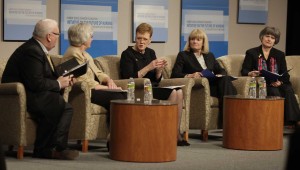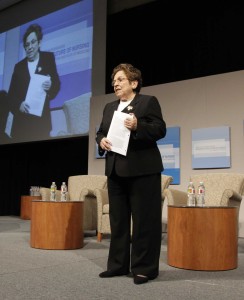
Last year, the Robert Wood Johnson Foundation commissioned an Institute of Medicine (IOM) initiative on The Future of Nursing. The goal of this initiative is to define a clear agenda and blueprint for action that identifies vital roles for nurses in implementing a more effective and efficient health care system. To do so, the IOM has hosted three forums on the future of nursing in November, December, and last Monday, February 22, 2010. From these meetings, a report will be released in October 2010. This third and final hearing focused on nursing education. Discussions centered on “What We Should Teach,” “How We Should Teach,” and “Where We Should Teach.”
Gerontological nursing advocates Elaine Taglierini, EdD, RN, president of the National League for Nursing, and Terry Fulmer, PhD, RN, dean of the New York University College of Nursing, spoke in the first discussion, “What We Should Teach.” They presented compelling testimony about the importance of educating nurses to care for older adults and set the tone for the meeting, which featured themes of aging and interdisciplinary collaboration throughout all the panels. As a representative of a funder focused on aging and health, I found this incredibly rewarding.

When the chair of the IOM Future of Nursing committee, Donna Shalala, PhD, offered the rare opportunity to hear impromptu testimony from the floor, I jumped at the chance, buoyed by the fact that others in the room were promoting gerontological nursing as well.
And here is what I said:
In order to be thoughtful about the future of nursing, we need to consider the characteristics of the patient of the future and tailor the education of nurses accordingly.
As heard throughout the morning, an overwhelming number of future patients will be older adults—approximately 71 million by 2030. They will range from the well elderly to those with complex or chronic care needs. And these older adults will increasingly seek out/utilize coordinated services in the community.
Nursing education, therefore, should reflect the health care needs and desired outcomes of the older patient with regards to competencies, technology—including simulation and e-Learning, clinical experiences, as well as the focus of the science generated. And the learning must happen within the context of a formalized, structured interdisciplinary environment.
As the largest private funder focused on aging and health, these are priorities of the John A. Hartford Foundation, and it is extremely encouraging to hear the themes of our aging society and team care throughout today’s panels on nursing education. It is our firm belief that more gero-expert nursing faculty are needed to be in the classroom educating all nurses at all levels and regardless of specialization to be skilled to care for the population they will inevitably be working with in the future—that of older adults.
If you’d like to hear my testimony as well as Elaine’s and Terry’s, here is the link to the meeting webcast. (You need to register in order to watch the webcast.) As advocates for gerontological nursing, how did we do? Given a platform, what would you say?
